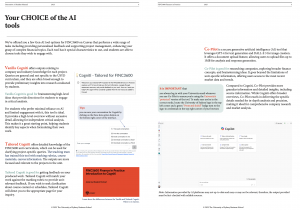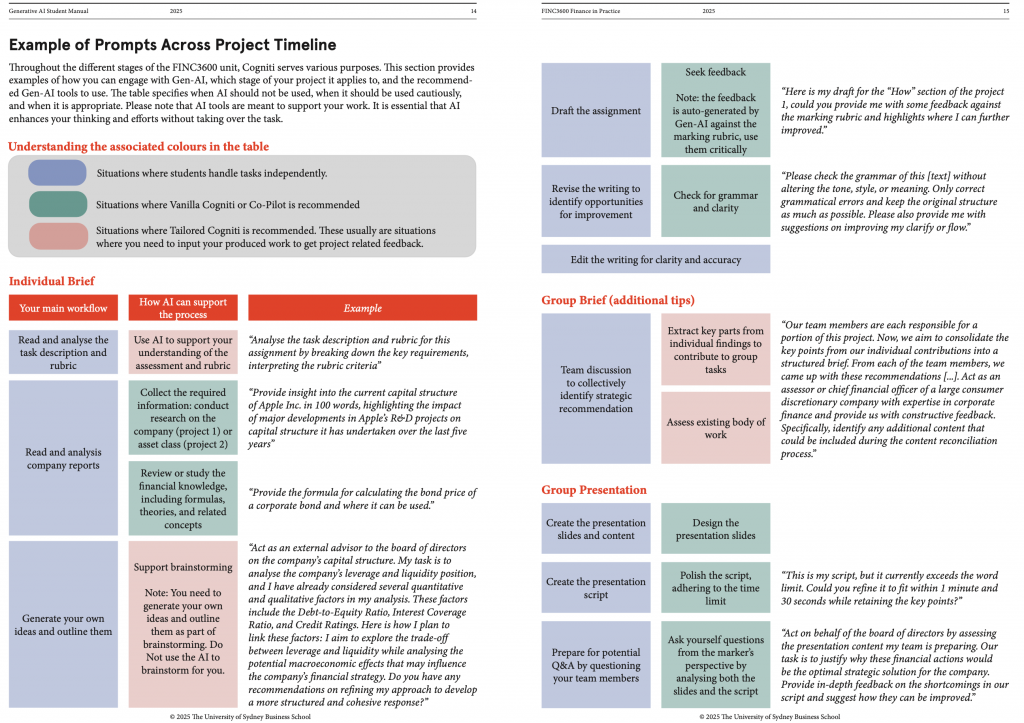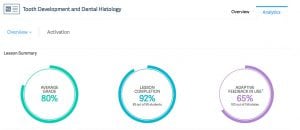The University of Sydney has adopted a ‘two-lane approach’ to balance assurance and human-AI collaboration in assessment design. This approach encourages educators to integrate AI into learning and assessment processes while building students’ Gen-AI literacy. By doing so, we aim to prepare students for a future where AI plays a significant role in various industries, including finance.
I coordinate a third-year finance capstone unit with approximately 700 students nearing graduation. As the finance industry increasingly adopts Gen-AI in business operations, we recognised the need to ensure our students develop essential Gen-AI literacy for solving finance problems before they graduate. In S2 2024, we implemented a pilot program incorporating the University’s Gen-AI platform Cogniti into our unit, supported by a USYD strategic education grant.
Phase 1: Piloting Gen-AI in the classroom

During the semester, we provided both a vanilla version and a tailored version of Cogniti to students, with the tailored version trained using unit materials and marking rubric for all the major projects. These tools are introduced to students in the first two weeks during the in-class time to ensure all students receive proper training and develop awareness of the tool’s capabilities, rather than leaving them to explore independently. As the unit progressed, additional just-in-time support materials co-created with student partners, Annie Gu and Soham Pathak, were introduced through Canvas.
Identifying student challenges
Our end-of-semester student feedback revealed several important challenges regarding effective Gen-AI usage:
- Two weeks of AI introduction are insufficient to establish engagement habits. Two weeks of AI introduction proved insufficient for students to develop self-motivated engagement patterns with these tools.
- Negative experiences led to tool disengagement. When students didn’t get their desired results from Cogniti, they disengaged rather than persisting or refining their approach.
- Academic integrity concerns created hesitation. Students struggled with uncertainty about when and how they could use AI without breaching academic integrity, as boundaries varied across different tasks and types of AI engagement.
- Students needed concrete examples of effective prompting. There was a clear demand for step-by-step exemplars showing how to modify and write prompts for different academic tasks.
These insights highlighted prompt writing as a significant hurdle for students. Assessment pressure also discouraged experimentation with different AI approaches. Recognising these challenges, we developed tailored Gen-AI guidance for S1 2025 that provides more hands-on assistance, including step-by-step examples, clear academic integrity guidelines, and structured opportunities for practice throughout the semester. This approach aims to build student confidence gradually while emphasising the iterative nature of effective AI interaction.
Phase two: co-creating unit-specific Gen-AI guidance with students
Building on our pilot program experience in semester 2, 2024, student partners Deepika Dhulipati and Xin (Alice) Meng used their firsthand experiences with Gen-AI in capstone projects to help develop tailored guidance for the unit in semester 1, 2025. Together, we created resources that address how students can use Gen-AI thoughtfully, critically, and ethically. The guide walks students through three key areas:

1. Selecting the right AI tool for the task
We introduce the different AI tools available in the unit, explaining the best use cases for each. This helps students make informed choices about which tool best matches their specific needs and engagement preferences.
2. Navigating ethical considerations
Our guide addresses academic integrity, data privacy, and proper acknowledgment of AI use. Clear guidelines help students confidently make decisions about when and how to incorporate AI, reducing anxiety about potential academic integrity breaches. Check out the Academic Integrity page for students for more information on the institution’s guidance.
3. Developing effective prompting skills
Using specific examples from the capstone unit, we demonstrate different levels of prompt complexity and teach students the RTRI method to structure a prompt by clearly defining the Role, Task, Request, and Input. The guide emphasises that AI should complement, not replace, independent thinking and learning. We position AI as a tool to enhance understanding, provide feedback, and refine work while students maintain control of their analytical and decision-making processes.

Need inspiration for writing tailored prompts for your student? Check out our student partners’ work on the AI in Education Canvas Site.
Key takeaway for educators
Gen-AI can reduce cognitive load for students, but may actually increase it if students must learn multiple AI tools while managing their regular coursework. Providing tailored, easy-to-implement guidance makes a significant difference in students’ ability to effectively incorporate these tools into their learning process.
If you’d like to see our Gen-AI guide, please reach out to [email protected]





